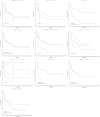Epidemiological characteristics and prognostic risk factors of pulmonary blastoma based on the 2021 WHO classification
- PMID: 40594926
- PMCID: PMC12218287
- DOI: 10.1038/s41598-025-08571-5
Epidemiological characteristics and prognostic risk factors of pulmonary blastoma based on the 2021 WHO classification
Abstract
Pulmonary blastoma (PB) is a rare and aggressive lung malignancy. Prior studies were confounded by inconsistent histological classifications, particularly before the 2021 World Health Organization (WHO) reclassification. This study aimed to characterize PB's epidemiological features and prognostic factors under the updated 2021 WHO criteria. Data on patients diagnosed with PB from the The Surveillance, Epidemiology, and End Results (SEER) database between 2000 and 2020 were collected. Kaplan-Meier curves were used to evaluate overall survival (OS), and univariate/multivariate Cox regression analysis was employed to identify independent factors affecting prognosis. PB affected females more frequently (61.5%) and occurred across all ages without a clear peak. The median tumor size was 77.83 mm, with upper/lower lung lobes being common sites. Surgical resection was performed in 73.8% of patients. The 1-, 3-, and 5-year OS rates were 70.3%, 57.2%, and 51.9%, respectively. Multivariate analysis revealed age, histological grade, and surgical status as independent prognostic factors. This study provides the first comprehensive analysis of PB under the 2021 WHO classification, demonstrating improved survival outcomes compared to historical reports. Age, histological grade, and surgical intervention are critical prognostic determinants. These findings underscore the importance of accurate histological classification and surgical resection in optimizing PB management.
Keywords: Epidemiological characteristics; Pulmonary Blastoma; Rare lung malignancy; Risk factors.
© 2025. The Author(s).
Conflict of interest statement
Declarations. Competing interests: The authors declare no competing interests. Ethics approval: All data were obtained from open databases, and therefore ethical approval was not required.
Figures
References
-
- Barnett, N. & Barnard, W. G. Some unusual thoracic tumors. BR. J. Surg.32, 441–457 (1945).
-
- Nicholson, A. G. et al. The 2021 WHO classification of lung tumors: impact of advances since 2015. J. Thorac. Oncol.17 (3), 362–387 (2022). - PubMed
-
- Tsao, M. S., Nicholson, A. G., Maleszewski, J. J., Marx, A. & Travis, W. D. Introduction to 2021 WHO classification of thoracic tumors. J. Thorac. Oncol.17 (1), e1–4 (2022). - PubMed
MeSH terms
LinkOut - more resources
Full Text Sources
Medical



